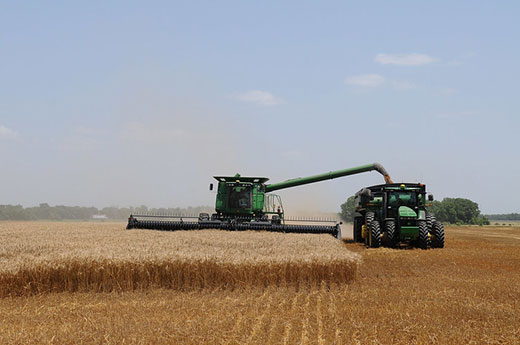
Preliminary data from the Kansas Farm Management Association indicates that Kansas grain farms’ net farm income fared better in 2020 than earlier expected. | Download this photo.
Kansas net farm income climbed in 2020 despite COVID-19; 2021 looks promising
Economists give early estimate and projections for 2021
Feb. 17, 2021
MANHATTAN, Kan. – Kansas farms appear to be moving out of the shadow of the global pandemic, according to two Kansas State University agricultural economists.
Ad hoc government payments made because of the pandemic and higher than expected grain prices since last summer boosted average estimates for 2020 Kansas net farm income to $137,000, a 7% increase over $128,000 the previous year.
Listen to an interview by Eric Atkinson with Gregg Ibendahl on the weekday radio program, Agriculture Today
Even though 2020 is past, the $137,000 is still an estimate. K-State economists will not have final numbers from the KFMA until the end of May.
The outlook is a far cry from what was expected late last spring. In May 2020, an initial estimate of Kansas Farm Management Association net farm income was produced, said K-State associate professor Gregg Ibendahl. Using KFMA member farms as a baseline at that time, K-State economists predicted an 87% drop in net farm income.
KFMA member farmers work with agricultural economists across the state to enhance members’ production and financial management skills.
“At the time, COVID-19 was starting to spread across the U.S. and the economic effect on much of the country was devastating,” Ibendahl said. “Prices for both grains and livestock had dropped, leading to questions about how severe the crisis might be for farmers.”
Since then, the profitability outlook changed course on two key developments, according to Ibendahl, an agricultural economist with K-State Research and Extension. First, the USDA announced programs to help both livestock and grain producers affected by the pandemic. The Coronavirus Food Assistance Program (CFAP) provided $23.6 billion to producers through the first two rounds of the program. Additionally, grain prices rose last summer and are now at levels not seen since before the pandemic.
In developing their estimates, Ibendahl and extension agricultural economist Dan O’Brien addressed seven major areas, including yields, prices, crop acres, expenses, crop insurance, government payments from the farm bill, and CFAP or ad hoc government payments. Each area was projected down to the farm level to estimate net farm income for each of the 588 KFMA grain farms for 2020 and 2021.
Their full preliminary report issued Feb. 3 is available online. A more complete analysis of 2020 Kansas net farm income based on KFMA data will be available this spring.
“While it originally appeared that COVID-19 was going to play havoc with net farm income, the average grain farm at least will come through the year (2020) with higher profitability,” Ibendahl said, but noted that not all farms will weather the market effects of the pandemic as well as the average grain farm.
The economists projected that net farm income in 2021 could increase another 35% to $185,000, based on futures prices. Those projections are uncertain, however, and hinge at least in part on whether futures prices translate to actual higher farm prices and if rainfall amounts are normal enough to allow for average yields.
The team also cautioned that the western United States is in a La Nina drought, so the prospect of average yields is questionable. In addition, higher grain prices tend to lead to higher expenses for fuel, fertilizer and seeds, which could cut into farm profitability.
An Agriculture Today podcast featuring Ibendahl speaking on this topic, plus other speakers and topics is available online.

